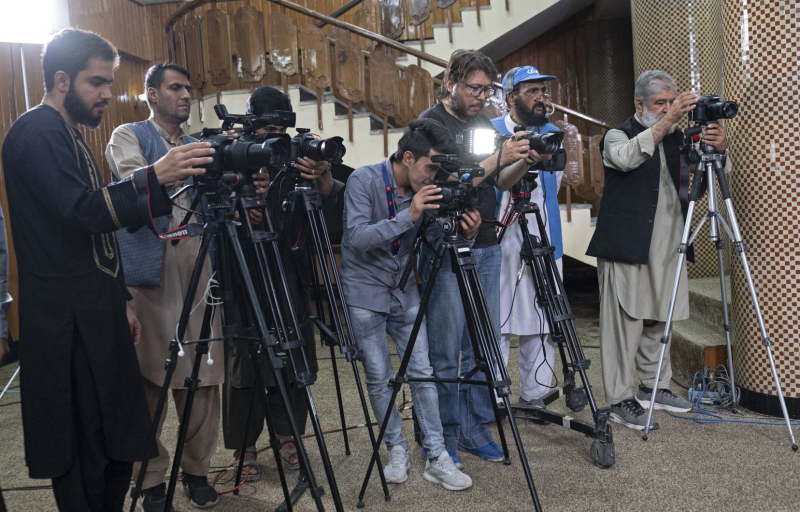
Photo: Wakil Kohsar Agence France-Presse Afghan journalists attend a press conference by Afghan Foreign Minister Amir Khan Muttaqi in Kabul, September 19, 2024.
Agence France-Presse in Kabul
Published at 12:27
- Middle East
Afghanistan’s Taliban government pledged Monday to ban media outlets from publishing images of living beings, adding that journalists in several provinces had been notified of the gradual implementation of the measure.
“The law applies throughout Afghanistan […] and it will be implemented gradually,” Saiful Islam Khyber, spokesman for the Ministry for the Promotion of Virtue and Prevention of Vice (PVPV), told AFP, arguing that images of living beings violated Islamic law.
The Taliban authorities issued a 35-article law over the summer to “promote virtue and prevent vice” among the population, in line with the sharia (Islamic law) they have been imposing since their return to power in Kabul in 2021.
“There is no place for coercion in law enforcement,” the PVPV said. “It is only about giving advice and convincing people that these things are truly against sharia and should be avoided.”
The text contains several measures targeting news media, including a ban on publishing images of living beings, as well as “content that is hostile to sharia and religion” or that “humiliates Muslims.”
200% Deposit Bonus up to €3,000 180% First Deposit Bonus up to $20,000However, several aspects of the law have not yet been strictly implemented, and Taliban authorities continue to regularly post photographs of people on social media.
“Efforts are underway in many provinces to implement the media-related sections of the law, but this has not started in all provinces,” Khyber said.
Censored Fish
He added that “work has started” in the Taliban stronghold of Kandahar (south), and in the provinces of Helmand (southwest) and Takhar (northeast).
Before the recent announcement of the law, the Taliban in Kandahar were already banned from filming or photographing living beings, but that rule did not apply to news media. “Now it applies to everyone,” Mr. Khyber said.
Journalists in Kandahar told AFP on Monday that they had not received any notice from the ministry and had not yet been arrested by the morality police for taking photos or videos.
On Sunday, PVPV officials summoned local journalists in the central province of Ghazni and told them that the morality police would begin to gradually enforce the law.
They advised reporters to take pictures from further away and to film less in order to “get used to it,” one journalist, who declined to give his name for fear of reprisals, told AFP.
In a similar meeting, journalists in the central province of Wardak were also informed that This rule would be implemented gradually.
Images of living beings were banned across the country when the Taliban ruled from 1996 to 2001, but a similar decree has yet to be imposed on a large scale since their return to power in 2021 after two decades of insurgency.
Since then, however, officials have sporadically forced businesses to follow certain censorships, such as crossing out the faces of men and women in advertisements, covering the heads of mannequins in shop windows with plastic bags, and hiding the eyes of fish depicted on restaurant menus.
When the Taliban returned, Afghanistan had 8,400 media workers, including 1,700 women. Only 5,100 remain, including 560 women, according to industry sources.
Dozens of media outlets have been closed and Afghanistan has fallen from 122nd to 178th place out of 180 in the Reporters Without Borders (RSF) press freedom rankings in three years.
Read also
- Taliban say new morality law will be applied sparingly

